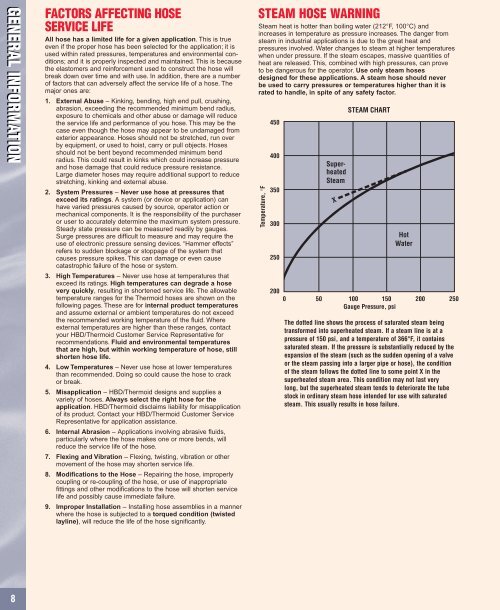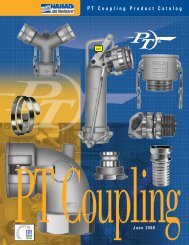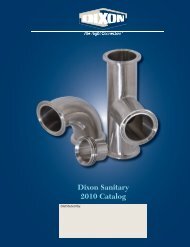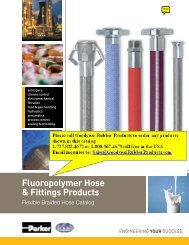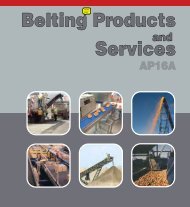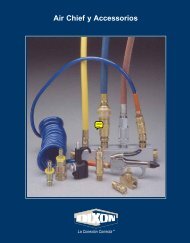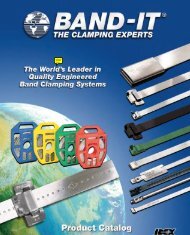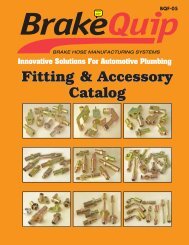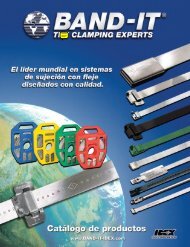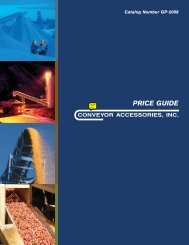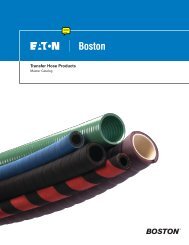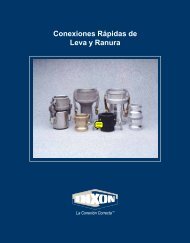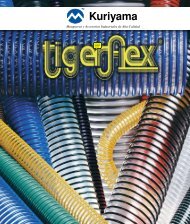HOSE PRODUCTS
Thermoid Industrial Hose Division - Goodyear
Thermoid Industrial Hose Division - Goodyear
- No tags were found...
You also want an ePaper? Increase the reach of your titles
YUMPU automatically turns print PDFs into web optimized ePapers that Google loves.
GENERAL INFORMATION<br />
FACTORS AFFECTING <strong>HOSE</strong><br />
SERVICE LIFE<br />
All hose has a limited life for a given application. This is true<br />
even if the proper hose has been selected for the application; it is<br />
used within rated pressures, temperatures and environmental conditions;<br />
and it is properly inspected and maintained. This is because<br />
the elastomers and reinforcement used to construct the hose will<br />
break down over time and with use. In addition, there are a number<br />
of factors that can adversely affect the service life of a hose. The<br />
major ones are:<br />
1. External Abuse – Kinking, bending, high end pull, crushing,<br />
abrasion, exceeding the recommended minimum bend radius,<br />
exposure to chemicals and other abuse or damage will reduce<br />
the service life and performance of you hose. This may be the<br />
case even though the hose may appear to be undamaged from<br />
exterior appearance. Hoses should not be stretched, run over<br />
by equipment, or used to hoist, carry or pull objects. Hoses<br />
should not be bent beyond recommended minimum bend<br />
radius. This could result in kinks which could increase pressure<br />
and hose damage that could reduce pressure resistance.<br />
Large diameter hoses may require additional support to reduce<br />
stretching, kinking and external abuse.<br />
2. System Pressures – Never use hose at pressures that<br />
exceed its ratings. A system (or device or application) can<br />
have varied pressures caused by source, operator action or<br />
mechanical components. It is the responsibility of the purchaser<br />
or user to accurately determine the maximum system pressure.<br />
Steady state pressure can be measured readily by gauges.<br />
Surge pressures are difficult to measure and may require the<br />
use of electronic pressure sensing devices. “Hammer effects”<br />
refers to sudden blockage or stoppage of the system that<br />
causes pressure spikes. This can damage or even cause<br />
catastrophic failure of the hose or system.<br />
3. High Temperatures – Never use hose at temperatures that<br />
exceed its ratings. High temperatures can degrade a hose<br />
very quickly, resulting in shortened service life. The allowable<br />
temperature ranges for the Thermoid hoses are shown on the<br />
following pages. These are for internal product temperatures<br />
and assume external or ambient temperatures do not exceed<br />
the recommended working temperature of the fluid. Where<br />
external temperatures are higher than these ranges, contact<br />
your HBD/Thermoid Customer Service Representative for<br />
recommendations. Fluid and environmental temperatures<br />
that are high, but within working temperature of hose, still<br />
shorten hose life.<br />
4. Low Temperatures – Never use hose at lower temperatures<br />
than recommended. Doing so could cause the hose to crack<br />
or break.<br />
5. Misapplication – HBD/Thermoid designs and supplies a<br />
variety of hoses. Always select the right hose for the<br />
application. HBD/Thermoid disclaims liability for misapplication<br />
of its product. Contact your HBD/Thermoid Customer Service<br />
Representative for application assistance.<br />
6. Internal Abrasion – Applications involving abrasive fluids,<br />
particularly where the hose makes one or more bends, will<br />
reduce the service life of the hose.<br />
7. Flexing and Vibration – Flexing, twisting, vibration or other<br />
movement of the hose may shorten service life.<br />
8. Modifications to the Hose – Repairing the hose, improperly<br />
coupling or re-coupling of the hose, or use of inappropriate<br />
fittings and other modifications to the hose will shorten service<br />
life and possibly cause immediate failure.<br />
9. Improper Installation – Installing hose assemblies in a manner<br />
where the hose is subjected to a torqued condition (twisted<br />
layline), will reduce the life of the hose significantly.<br />
STEAM <strong>HOSE</strong> WARNING<br />
Steam heat is hotter than boiling water (212°F, 100°C) and<br />
increases in temperature as pressure increases. The danger from<br />
steam in industrial applications is due to the great heat and<br />
pressures involved. Water changes to steam at higher temperatures<br />
when under pressure. If the steam escapes, massive quantities of<br />
heat are released. This, combined with high pressures, can prove<br />
to be dangerous for the operator. Use only steam hoses<br />
designed for these applications. A steam hose should never<br />
be used to carry pressures or temperatures higher than it is<br />
rated to handle, in spite of any safety factor.<br />
Temperature, °F<br />
450<br />
400<br />
350<br />
300<br />
250<br />
200<br />
Superheated<br />
Steam<br />
X<br />
STEAM CHART<br />
Hot<br />
Water<br />
0 50 100 150 200 250<br />
Gauge Pressure, psi<br />
The dotted line shows the process of saturated steam being<br />
transformed into superheated steam. If a steam line is at a<br />
pressure of 150 psi, and a temperature of 366°F, it contains<br />
saturated steam. If the pressure is substantially reduced by the<br />
expansion of the steam (such as the sudden opening of a valve<br />
or the steam passing into a larger pipe or hose), the condition<br />
of the steam follows the dotted line to some point X in the<br />
superheated steam area. This condition may not last very<br />
long, but the superheated steam tends to deteriorate the tube<br />
stock in ordinary steam hose intended for use with saturated<br />
steam. This usually results in hose failure.<br />
8


